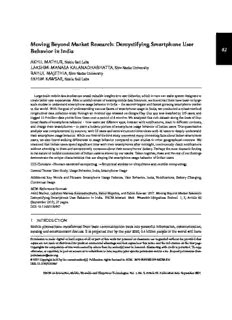
Demystifying Smartphone User Behavior in India PDF
Preview Demystifying Smartphone User Behavior in India
Moving Beyond Market Research: Demystifying Smartphone User 82 Behavior in India AKHILMATHUR,NokiaBellLabs LAKSHMIMANASAKALANADHABHATTA,ShivNadarUniversity RAHULMAJETHIA,ShivNadarUniversity FAHIMKAWSAR,NokiaBellLabs Large-scalemobiledatastudiescanrevealvaluableinsightsintouserbehavior,whichinturncanassistsystemdesignersto createbetteruserexperiences.Afteracarefulreviewofexistingmobiledataliterature,wefoundthattherehavebeennolarge- scalestudiestounderstandsmartphoneusagebehaviorinIndia–thesecond-largestandfastestgrowingsmartphonemarket intheworld.WiththegoalofunderstandingvariousfacetsofsmartphoneusageinIndia,weconductedamixed-method longitudinaldatacollectionstudythroughanAndroidappreleasedonGooglePlay.Ourappwasinstalledby215users,and logged11.9milliondatapointsfromthemoveraperiodof8months.Weanalyzedthisrichdatasetalongthelinesoffour broadfacetsofsmartphonebehavior–howusersusedifferentapps,interactwithnotifications,reacttodifferentcontexts, andchargetheirsmartphones–topaintaholisticpictureofsmartphoneusagebehaviorofIndianusers.Thisquantitative analysiswascomplementedbyasurveywith55usersandsemi-structuredinterviewswith26userstodeeplyunderstand theirsmartphoneusagebehavior.Whileourfirst-of-its-kindstudyuncoveredmanyinterestingfactsaboutIndiansmartphone users,wealsofoundstrikingdifferencesinusagebehaviorcomparedtopaststudiesinothergeographicalcontexts. We observedthatIndianusersspendsignificanttimewiththeirsmartphonesaftermidnight,continuouslychecknotifications withoutattendingtothemandareextremelyconsciousabouttheirsmartphones’battery.Perhapsthemostdramaticfinding isthenatureofmobileconsumerismofIndianusersasshownbyourresults.Takentogether,theseandtherestofourfindings demonstratetheuniquecharacteristicsthatareshapingthesmartphoneusagebehaviorofIndianusers. CCSConcepts:•Human-centeredcomputing→Empiricalstudiesinubiquitousandmobilecomputing; GeneralTerms:UserStudy,UsageBehavior,India,SmartphoneUsage AdditionalKeyWordsandPhrases: SmartphoneUsagePatterns, UserBehavior, India, Notifications, BatteryCharging, ContextualUsage ACMReferenceformat: AkhilMathur,LakshmiManasaKalanadhabhatta,RahulMajethia,andFahimKawsar.2017.MovingBeyondMarketResearch: Demystifying Smartphone User Behavior in India. PACM Interact. Mob. Wearable Ubiquitous Technol. 1, 3, Article 82 (September2017),27pages. DOI:10.1145/3130947 1 INTRODUCTION Mobilephoneshavetransformedfrombasiccommunicationtoolsintopowerfulinformation,communication, sensingandentertainmentdevices.Itisprojectedthatbytheyear2020,5.4billionpeopleintheworldwillhave Permissiontomakedigitalorhardcopiesofallorpartofthisworkforpersonalorclassroomuseisgrantedwithoutfeeprovidedthat copiesarenotmadeordistributedforprofitorcommercialadvantageandthatcopiesbearthisnoticeandthefullcitationonthefirstpage. Copyrightsforcomponentsofthisworkownedbyothersthantheauthor(s)mustbehonored.Abstractingwithcreditispermitted.Tocopy otherwise,orrepublish,topostonserversortoredistributetolists,requirespriorspecificpermissionand/orafee.Requestpermissionsfrom [email protected]. ©2017Copyrightheldbytheowner/author(s).PublicationrightslicensedtoACM. 2474-9567/2017/9-ART82$15 DOI:10.1145/3130947 PACMonInteractive,Mobile,WearableandUbiquitousTechnologies,Vol.1,No.3,Article82.Publicationdate:September2017. 82:2 • AkhilMathur,LakshmiManasaKalanadhabhatta,RahulMajethia,andFahimKawsar amobilephone–morethanthoseprojectedtohaveelectricity(5.3billion),runningwater(3.5billion)orcars (2.8billion)[2].Thisrapidgrowthinsmartphoneownership,coupledwiththeemergenceofappdistribution channelssuchasGooglePlayandApple’sAppStore,hasmadeitpossibleforappdeveloperstoreachmillionsof usersaroundtheworldwithvaryinggeographical,social,economicandculturalbackgrounds. Tostudysmartphoneusagepatternsamongusers,ubicompresearchershavealsoleveragedthesameapp distributionchannelsandconductedvariouslargescale,in-the-wildstudieswithrealsmartphoneusers.Falakiet al.[13]conductedacomprehensivestudyofsmartphoneusagetocharacterizetheimpactofuserinteractionswith thedeviceonnetworkandenergyconsumption.Ferreiraetal.[15]analyzedthecontextualnatureofapplication micro-usage,andfoundthatsocialapplicationsaretheprimarytriggersforuser-initiatedmicro-usagesessions. Otherworkshavestudiednotificationdeliveryonsmartphones[29,31,37],mobileenergyconsumption[22], andpredictionofnextappuse[39]. Despitetheincreasedresearchactivityinthisspace,weobservethattherehavebeennomobiledatastudies aimedatunderstandinguserbehaviorinoneofthemajorsmartphonemarketsintheworld,namelyIndia.Most oftheexistingmobiledatastudies(e.g., [13,32])wereconductedwithusersinWesterncountriesandthustheir findingsmaynotreflecttheuserbehaviorinIndia. Akeyreasonforthismajorgapinmobiledataliterature isthatthesmartphonemarketinIndiahasonlymaturedinthelastfewyears.Priortothat,themobilephone marketwasdominatedbylow-endfeaturephoneswhichhaddulypromptedanumberofHCIstudies[16,25] ondesigningtechnologysolutionsforresource-constraineddevices.Onlyinthelastfewyearshastherebeen massivesmartphoneadoptioninIndia,makingitcurrentlythesecondlargestsmartphonemarketandthecountry withthehighestAndroiddeviceusagetimeintheworld[5].Thissuggeststhatsmartphoneshaveindeedbecome ubiquitousinIndia,anditisanopportunetimetostudyhowusersinIndiaareinteractingwiththeirsmartphones. In addition to the large user base, there is another reason that makes it interesting to study smartphone behaviorinanIndiancontext:ononehand,IndiahasalargeurbanEnglish-speakingpopulation,manyofwhom areemployedintheglobaltechnologyindustryandwhosesmartphoneusagepatternsmightoverlapwithglobal usagepatterns.However,therearealsomajordifferencesintermsofinfrastructureavailability(e.g.,electricity supply,internetspeeds)andeverydayculturalandsocialnorms,whichmightleadtouniquevariationsinuser behaviorinthiscontext.Assuch,wearguethatitiscriticalformobiledevelopersandubicompresearchersto obtainanin-depthunderstandingofhowusersinIndiainteractwiththeirsmartphones,soastodesignbetter mobilesystemsandexperiencesforthefastestgrowingsmartphonemarketintheworld. Inthispaper,wepresentamixed-methodlongitudinalstudywhichprovidesaholisticviewofthesmartphone usagebehaviorofIndianusers.Our8-monthstudywasconductedthroughanappreleasedonGooglePlay.A totalof215AndroidsmartphoneusersfromIndiaparticipatedinthestudy,generatingnearly11.9milliondata pointsrelatedtosmartphoneusageandcontext.Thisquantitativedataloggingwasfollowedbyanonlinesurvey of55usersandin-depthinterviewsof26usersfromtheoriginaluserpooltofurtherunderstandtheirmobile usagebehavior.AsthisisthefirsteverlongitudinalubicompstudyinanIndiancontext,ourgoalinthispaperis topaintabroadpictureofthesmartphoneusagebehaviorofIndianusersratherthanunderstandingaparticular micro-behavioralpatternaboutthisgroup.Tothisend,ourdataanalysisfollowsahighlyexploratoryapproach, whereinweanalyzethecollectedsmartphoneusagedatathroughfourbroadlensesthatarehighlyrelevantfor theubicompcommunity: • ApplicationUsageAnalysis: AccordingtothemarketresearchfirmAppAnnie[1],Indianusersrecorded thehighestnumberofAndroidappdownloads(6.2billionapps)intheworldin2016. Weexplorethe temporalvariationsinappusageofthisusergroup,uncoverthemotivationsbehindinstallation,usage anduninstallationofcertainapps,andanalyzetherelationshipbetweenusageofvariousappcategories. • NotificationAnalysis: Inthemodernsmartphoneusageparadigm,notificationsservetheverycrucialrole ofpromotingcontentawarenessbyalertinguserstonewlyavailableinformation.Therefore,weanalyze PACMonInteractive,Mobile,WearableandUbiquitousTechnologies,Vol.1,No.3,Article82.Publicationdate:September2017. MovingBeyondMarketResearch:DemystifyingSmartphoneUserBehaviorinIndia • 82:3 thereceptivityofIndianuserstowardsmobilenotifications,andexploreifnotificationdeliverycontext hasanyimpactonitsreceptivity. • ContextAnalysis: Asoundunderstandingofuserbehaviorindifferentcontextscanhelppractitionersin designingadaptableubicompsystems.Assuch,weexploretheroleofpersonalcontext,devicecontext, andsocio-economiccontextinshapingthesmartphoneusageofIndianusers. • ChargingBehaviorAnalysis: Human-batteryinteractionhasbeenanimportantresearchtopicinubicomp research. By accurately understanding the battery charging preferences of users, mobile apps can intelligentlyscheduletheirenergy-heavyoperations.Inthisvein,weanalyzethedurationandtemporal distributionofchargingsessionsforIndianusers,aswellastheimpactofbatterylevelsonusers’decision tochargetheirphones. WhileuncoveringthesmartphoneusagepatternsofusersinIndiaistheprimarygoalofthispaper,ourwork alsobuildsupontherecentmobiledataresearchinthecommunity.Inarecentcritiqueonmobiledatastudies, Churchetal.[8]arguedthatubicompandHCIresearchcommunitiesshouldencourage“reproducingofmobile datastudiesindifferentpartsoftheworld,withdifferentuserpopulationsandatdifferentpointsintime”asthis willenableustocombineandcontrastthefindingsfromvariouscontextsandgeographies,andbuildabetter andmorecompleteunderstandingofuserbehavior.Wefundamentallyagreewiththispositionandtherefore,in thispaper,inadditiontothoroughlyanalyzingthesmartphonebehaviorforusersinIndia,wealsocontrastit againstpublishedmobiledatastudieswhichwereconductedinothergeographicalsettings.Morespecifically,we highlightthesimilaritiesanddifferencesinuserbehavioracrossgeographies,andshowthatifthesenuances arenottakenintoaccountwhiledesigningdata-drivenmobilesystems,theperformanceofthesesystemscould significantlydegradein-the-wild. Someofourmostinterestingfindingsare:a)usersinIndiaareextremelyconsciousabouttheirsmartphone’s batterylevel–smartphonesarechargedveryfrequentlyinordertomaintainahighbatterylevel,andnearly50% ofthechargingsessionshappenwithin80minutesofthelastsession,b)whileusersareremarkablyquickto glanceatincomingnotificationsontheirdevices,theattendancerateofnotificationsremainsverylow,c)the temporalpatternsofappusageamongIndianusersareinstarkcontrastwiththefindingsofpriormobiledata studiesinWesterncontexts,andfinallyd)wefoundevidenceinourdatathatthe‘app-only’businessmodel pitchedbye-commerceprovidersinIndiagoesagainstthebehavioralpatternsoftheusers. Insummary,thispapermakesthefollowingcontributionstomobiledataliterature: • WepresentthefirsteverlongitudinaldatacollectionstudyanalyzingsmartphoneusagepatternsinIndia, fromtheperspectiveoffourkeyfacetsofsmartphoneusage. • OurfindingsthrowlightonseveralpreviouslyunknownaspectsofsmartphoneuserbehaviorinIndia, andofferaholisticunderstandingofthefastestgrowingsmartphonemarketintheworld. • Wepresentadetailedanalysisofthevariationsinsmartphoneusagepatternsacrossmultiplegeographical regions,anddiscussitsimplicationsfortheubicompcommunity. 2 RELATEDWORK Large-scaleMobileDataStudiesandtheirImplications. Inrecentyears,manymobiledatastudieshave beenconductedtoassesssmartphoneusagepatternsofvarioususergroups.Bohmeretal.studiedtheapplication life-cyclesonAndroidsmartphonesof4,125users,mainlyacrossEuropeandtheUS,overa5-monthperiod[7]. Oneoftheirkeyobservationswasthesurprisinglyshortdurationofappusagesessions. Ferreiraetal.[15] built upon their work and found that 41.5% of all application sessions lasted less than 15 seconds. Falaki et al.[13]evaluatedtheimpactofuserinteractionswiththedeviceonnetworkandenergyconsumption.Asimilar 9-month-longstudybyDoetal.[12],involving77Europeanparticipants,bringsoutlocality-basedapplication usagepatterns.Theyfoundthatuserstendtousemoresynchronouscommunicationmodes(suchasvoicecalls) PACMonInteractive,Mobile,WearableandUbiquitousTechnologies,Vol.1,No.3,Article82.Publicationdate:September2017. 82:4 • AkhilMathur,LakshmiManasaKalanadhabhatta,RahulMajethia,andFahimKawsar overothersinunknownornon-stationarylocations. Comparablecontextualresultshavealsobeenobserved byRahmatiandZhongamong15-to18-year-oldsfrombelowaverageincomehouseholdsinHouston,USA [35].Theyfoundthatparticipantsalsotendtospendmoreoftheirtime-andrecordlongersessions-inareas withbetterWiFiconnectivity. TheinfluenceofWiFiconnectivityhasbeenfurtherdiscussedbyBaumannet al.[6],whoseresultsshowthattheprobabilityofusersgeneratingdatatrafficonaWiFinetworkistwicethat onacellularconnection.Theimplicationsofsuchresultsisenormous,andhastherebyledtothedevelopment ofcomprehensivemodelsofuserbehaviorthatcanbeutilizedinordertoimproveusabilityandefficiencyof smartphones.AnexemplificationofthesameistheMarkovstatetransitionmodelofsmartphonescreenusethat hasbeendevelopedbyKostakosetal.asdescribedin [20]. BehaviorAnalysisonSmartphones. Studiesonsmallerscalehavealsobroughtupotherdetailsofbehavioral patternsofsmartphoneusers.Forinstance,Jonesetal.[18]exploreapp“revisitationpatterns”usinganapplication deployedonGooglePlay.Bystudyingtherevisitationcurvesshowinghowfrequentlyusersreturnedtoanapp, theywereabletoconfirmseveralintuitivestructuresofusage.VanBerkeletal.[42]discoveredandreported flawswiththeprevailingapproachofapproximatingsessions,findingthatwhenuserslockandunlocktheir smartphoneswithinashortduration(e.g.,lessthanaminute),theyaremorelikelytobeestablishinganewsession thancontinuingthepreviousone.Thiscounterintuitiveobservationcalledforfurtherresearchonsmartphone sessionapproximations,perhapsalongthelinesofthecomprehensivequantificationofsmartwatchsessions presentedbyVisurietal.in[43]. Notificationpreferencesofsmartphoneusershavealsobeenexploredinsignificantdetail.Mehrotraetal.[27] designedsmarternotificationmechanismsbyconstructingassociationrulesusingcombinationsoftextinthe notification titles and the user’s contextual aspects of activity, location and time. Mehrotra et al. [28] also designed classifiers to learn the most opportune moment to deliver notifications to users, based on content, socialrelationships,andapplicationcontext.Additionally,asimilarbehavioranalysisstudyaimedatyouthina KoreanuniversitywasalsoconductedbyLeeetal.[21].Thisstudy,involving95studentsforaperiodof67days, soughttoidentifysmartphoneusagepatternsofboth“high/at-risk”and“non-risk”groupsofusers,whohad beenclassifiedbypre-trialsurveys.Sensordatafromsmartphonesisalsobeingutilizedbyresearcherstostudy thebehaviorofusers.Tsapelietal.[41]detectthecausaleffectsofseveralfactorssuchasworking,exercising andsocializingonthestresslevelsof48students. Thedependencyofuserbehavioronthecontextoftheuserhasalsobeenexploredinpriorresearch. The collectionofqualitycontextualdatahasitselfbeenanopenchallenge.Liuetal.[23]foundthattheperceived needfordonationandtheperceivedorganizationreputationactasmainmotivatorstoencourageuserstodonate contextualdataforstudies.Numerousaspectsofcontextualdependencehavebeeninvestigatedinpaststudies. Forinstance,Karikoskietal.[19]studiedthecommunicationpatternsofusersbasedonparameterssuchastheir location,mobilenetworkcellID,WLANdataetc.todeterminetheirpreferenceforlengthofvoicecalls,intensity ofusageofemail/SMS,IMorVoIPservicesetc.Liuetal.[24]questioned267usersinChinatobuildanadoption modelofmobilegamingwhichindicatedthatcontextwasthebiggestinfluencerandpredictorofmobilegame adoption.Theresultsoftheabove-mentionedworksreiteratetheneedtoexaminethecontextualfactorsdriving userpractices. Anotherfacetofuserbehaviorthatmeritsin-depthdiscussionisthatofbatteryusage.Ferreiraetal.in [14] investigatechargingandbatteryusagepatternsofover4,000usersover4weeks. Thestudyhighlightedthe energywastagecausedbyusersnotunpluggingtheirphonesassoonasthechargingcyclecompleted.Moreover, itassertsthevaluethatusersassociatewiththebatterylifeoftheirdevices,whichisreiteratedbytheresults ofourindependentsurvey. Hosioetal.[17]haveattemptedtosystematicallymeasurethemonetaryvalueof smartphonebatterylifeandhavefoundthepricesofthefirstandlast10%batterysegmentstodiffersubstantially. PACMonInteractive,Mobile,WearableandUbiquitousTechnologies,Vol.1,No.3,Article82.Publicationdate:September2017. MovingBeyondMarketResearch:DemystifyingSmartphoneUserBehaviorinIndia • 82:5 Table1. Facetsofsmartphoneusagestudiedinthepaper,alongwiththeassociatedresearchquestions Facetsof ResearchQuestionsAddressed SmartphoneUsage Howistheapplicationusagedistributedtemporally? Howlongandhowfrequentareapplicationusagesessions? ApplicationUsage Whatmotivatesthechoiceofapplicationsamongusers? HowdoestheusageofVoIP&IPmessagingappscomparewithtraditionaltelephonyapps? Whydousersuninstallapps? Howquicklydousersrespondtoanotification? Notifications Howeffectivearenotificationsinengagingtheuser? Howdoesalertmodalityimpactanotification’sresponsetime? Howdoestheuser’sphysicalactivitycontextaffectapplicationusage? Howaresmartphoneusagepatternsimpactedbytheuser’slocation? UserContext Cantypeofnetworkconnectivityhaveaneffectonsmartphoneusagepatterns? Howdoesthebroadersocio-economiccontextaffectsmartphoneusageofIndianusers? Howdoesbatterychargingbehaviorvarytemporally? ChargingBehavior Howlongandhowfrequentarethechargingsessions? SmartphoneUsageStudiesinIndia. Asdiscussedpreviously,smartphoneusageinIndiahasbeenreaching newheightsintherecentyears.Accordingtoa2016reportbybusinessintelligencefirmAppAnnie[1],Indian usersspentastaggering150billionhoursonsmartphones,arisefromaround100billionhoursin2015.Thereport alsopredictsfurthergrowthinIndia’ssmartphonepenetration.Anotherpointtobenotedfromthereportisthat IndialeadsmarketssuchasChina,SouthKorea,UKandtheUSintermsoftheaveragenumberofshoppingapps installedperuser–pointingtotheadaptivityofIndianstowardsmobilee-commerceaswellastheirtendencyof comparingserviceprovidersbeforemakingapurchase.ThisissupportedbyDeshmukhetal.[10],whodiscuss theshiftfrome-commercetom-commerceinIndia,andanalyzethesocialfactorsthatsupportthistransition. However,ourunderstandingofIndiansmartphoneusersisprimarilyrestrictedtomarketingreportsgenerated bybusinessanalystfirms. Usuallythegoalofsuchreportsistostudythemarketopportunitiesandprovide guidancetobusinesses,ratherthanlookingintothenuancesofuserbehaviorthatcouldbeofinteresttomobile researchersanddevelopers.Whiletherehavebeensmall-scalefocusedstudiesinthemedicalliteraturewhich havelookedataddictioninmobilephoneusageamongIndianusers[9,11],tothebestofourknowledge,no large-scalestudyhaseverbeendonetodevelopaholisticunderstandingofsmartphoneusagebehaviorinIndia. Inthiswork,ourgoalistogatherlarge-scalesmartphoneusagedatafromIndianusers,andsystematically understandthevariousfacetsofsmartphoneuse. Webuilduponpriormobiledataresearchworks,andalso highlightuniqueaspectsofsmartphoneusageamongourtargetusergroup. 3 STUDYDESCRIPTION Inthissection,weprovidedetailsofouruserstudytocollectlarge-scalesmartphoneusagedatafromusersin India.Webeginbyprovidingthestudyoverview,whichisfollowedbyadescriptionofourdatacollectionsystem, studymethodology,andparticipantdemographics.Finally,wegiveasummaryofthedatalogscollectedinour study,andouranalysisplanforthesubsequentsections. PACMonInteractive,Mobile,WearableandUbiquitousTechnologies,Vol.1,No.3,Article82.Publicationdate:September2017. 82:6 • AkhilMathur,LakshmiManasaKalanadhabhatta,RahulMajethia,andFahimKawsar 3.1 Overview Thedomainofsmartphonedataanalysisisclearlyverybroad,asisevidentfromtheextensiveanddiverseresearch inthisareaasdiscussedin§2. Inthispaper,wefocusouranalysisonfourbroadfacetsofsmartphoneusage thatareparticularlyrelevanttotheubicompcommunity.Thesefourfacetsalongwiththeresearchquestions exploredwithineachfacetaretabulatedinTable1andexplainedbelow: ApplicationUsageAnalysis:Mobileapplicationsareatthecoreofthesmartphoneecosystem–in2016,atotal of90billionappsweredownloadedfromGooglePlayandAppleAppStore[1].Whileanumberofmarketing surveyshavebeenconductedonthegrowthandpotentialoftheIndianapp‘market’,tothebestofourknowledge, therehasbeennolarge-scaleresearchstudyintheubicompandmobilesystemscommunitythatprovidesdetailed insightsintotheapplicationusagebehaviorofthisusergroup.Inparticular,weexplorethetemporalpatternsof appusage,distributionofappsessions,motivationsbehindinstallation,usageanduninstallationofcertainapps,and relationshipbetweentheusageofvariousappcategories. Notification Analysis: An in-depth understanding of the human-notification interaction can help mobile developersincreatingintelligentnotificationdeliverymechanismsthatleadtohigheruserengagement.Our workspecificallylooksatthereceptivityandeffectivenessofmobilenotificationsamongIndianusers, andthe impactofalertmodalityonanotification’sresponsetime. ContextAnalysis:Priorubicompstudieshaveshownthatsmartphoneusagehasastrongdependencyonthe user context [19]. An accurate inference of the user context, combined with a sound understanding of user behaviorinthatparticularcontext,canhelpubicomppractitionersdesignmobilesystemsthatcanbetteradapt touserneeds.Inthispaper,weprimarilylookatfourkindsofcontextsthatmayinfluencesmartphoneusage behavior,namelylocationcontext,physicalactivitycontext,connectivitycontext,andsocio-economiccontext. ChargingBehaviorAnalysis:Modernsmartphoneapplicationsrunsophisticatedmobilesensing,inference andnetworkconnectivityoperationswhichimposeamajorburdenonthesmartphonebattery,andmayrequire userstochargethephonebatteriesatregularintervals.Byunderstandingthebatterychargingpatternsofthe end-users,mobiledeveloperscanscheduletheirenergy-heavyoperationstoopportunemoments–forexample, whenthebatterylevelishighorwhenauserislikelytochargethephone.Tothisend,weanalyzetheduration andtemporaldistributionofchargingsessions,aswellastheimpactofbatterylevelsonusers’decisiontocharge theirphones. Whilethesefourfacetsofsmartphoneusagehavewitnessedactiveresearchintheubicompcommunity,itis importanttoacknowledgethattherecouldbeotherinterestingaspectsofsmartphoneusagesuchasinfluenceof thesocialnetworkonusage,datatrafficpatterns,OS-specificvariationsinusageetc.whichareoutofscopeof thispaper,andcanbeexploredinfuturework. 3.2 Methodology In this section, we present our data collection system and provide details on our study methodology and participants. DataCollectionSystem: OurdatacollectionexercisefocusedonusersofAndroidOS–currently,Android hasa97%smartphonemarketshareinIndia[5],makingitaclearchoiceforalarge-scaleubicompstudy.We developedanAndroidapplicationwhichrunsonAndroid5.0+anddistributedittousersviaGooglePlay.The appisimplementedtorunasabackgroundserviceontheuser’sdeviceandpassivelyrecordsallusagesessions onthedevicealongwithvariouscontextualinformation. Table 2 details the five types of data points collected by the app. We used event-based Android APIs to collectapplicationdata,screenevents,notificationeventsandcalldata.Specifically,wheneveranewdatapoint PACMonInteractive,Mobile,WearableandUbiquitousTechnologies,Vol.1,No.3,Article82.Publicationdate:September2017. MovingBeyondMarketResearch:DemystifyingSmartphoneUserBehaviorinIndia • 82:7 Table2. Listofdatacollectedfromuser’sphones.(*User’sphysicalactivitywasobtainedbyqueryingtheAndroidActivity RecognitionAPIs) DataType Description Applicationdata Packagenamesofallappsinstalledonthephone,timestampsofapp open(anapp comingintoforeground)andapp close(anappgoingintobackground). Screenevents Timestampswhenthephonescreenisturnedon,offandunlocked. Notificationevents Timestampsofnotificationarrival,notificationaccessordismissal,nameofapplication whichsentthenotification.Thecontentinsidethenotificationwasnotcollectedfor privacyreasons. Callevents Timestamps of calls, call medium (cellular/VOIP), type of call (incom- ing/outgoing/missed). SensorandContext Batterylevel,celltowerID,WifiDetails(isConnected,BSSID),isHeadphoneConnected, proximitytothephone,ambientlightintensity,ambientsoundlevel,user’sphysical activity*. pertainingtothesecategoriesbecomesavailable(e.g.,anewnotificationisreceived),theAndroidOSfiresan eventwhichiscaughtbyourbackgroundserviceandtherequireddatapointsarelogged.Further,sensorand context data items listed in the last row of Table 2 were collected by polling Android APIs at i) the start of eachsmartphonesession(i.e.,wheneverthescreenwasturnedon),andii)onceevery2minutes.Theperiodic collectionofsensorandcontextdatawasdonetoensurethatdataiscollectedevenduringperiodsofinactivity. Alldatalogscollectedbytheapplicationarestoredlocallyonthephone,andareperiodicallyuploadedtoa remoteserver. SystemDeployment. WereleasedourdatacollectionapponGooglePlayStore,andsolicitedparticipation inthestudybypublicizingitonsocialforumsandemaillists. Morespecifically, weadvertisedthestudyin 6universitycampusesthroughemaillistsanduniversityforums,andin7industrialorganizations(primarily softwareandbusinessconsultingcompanies)throughemployeeforums.Thisresultedinatotalgeographical spreadofmorethan10urbancitiesand6statesinIndia.Inaddition,wealsoadvertisedthestudythroughpersonal socialnetworks,andparticipantswererecruitedthroughsnowballsampling. Whileparticipantrecruitment throughsocialforumsandemaillistsiswidelydoneinmobiledataliterature[32–34,42],thereisneverthelessa possibilityofsamplingbiasinthismethodofparticipantselection.Inourstudy,asparticipantrecruitmentwas doneacrossmultipleorganizationsinmorethan10urbancities,wearguethattheproblemofsamplingbiasis alleviatedtoalargeextent.However,wedonotclaimthatthesampleiscompletelyunbiasedandrepresentative foracountrywithapopulationof1.3billion.Thisisclearlyalimitationofourstudyandwithuserstudiesin general,andassuchwedulyacknowledgeitintheLimitationssectionin§6. Thedatacollectionforourstudywasdoneintwophases–thefirstphaseranfromDecember2015toJuly 2016andthesecondfromJanuary2017toFebruary2017.Thesecondphasewasprimarilymotivatedbyamajor socio-economicchangeinIndia–widelyreferredtoasDemonetization1–thattookplaceinNovember2016. WewantedtounderstandhowsmartphoneusageinIndiaadaptstochangesinbroadersocio-economiccontext (detailedin§4.3). 1TheIndiangovernmentannouncedonNovember8th,2016thatthetwohighest-valuecurrencynotesinthecountrywouldceasetobelegal tenderwithimmediateeffect.Oneoftheintendedgoalsofthisdecisionwastoencouragepeopletousedigitalpaymentmechanisms[3]. PACMonInteractive,Mobile,WearableandUbiquitousTechnologies,Vol.1,No.3,Article82.Publicationdate:September2017. 82:8 • AkhilMathur,LakshmiManasaKalanadhabhatta,RahulMajethia,andFahimKawsar ParticipantDemographics. Intotal,theapplicationwasinstalledby215users,whowereagedbetween18 to38years. 63ofthemidentifiedthemselvesasfemales. Forouranalysis, however, weonlyincludedusers contributingmorethanonemonthofdata.Thisfilteringstepresultedin160users(41females)agedbetween 18and38years. Whiletheagediversityinourparticipantgroupseemratherlow,itisactuallyinlinewith priorresearchbyPewResearchCenterwhichfoundthatonly9%ofthepopulationagedover35yearsownsa smartphoneinIndia[4]. 104outofthe160participantsidentifiedthemselvesasstudents,whiletheremainingwereworkingprofession- als.Exceptforthesebasicdemographics,wedidnotcollectanypersonalinformationfromtheusers.Duetothe inherentanonymityinourstudy,wedonotknowtheethnicitiesoftheparticipants,assuchourfindingsshould beinterpretedasapplicabletosmartphoneusersinanIndiancontextratherthanethnicIndianusers.Howeverfor brevity,werefertoourparticipantsasIndiansmartphoneusersinthepaper.Finally,asanincentiveforusingthe app,userswereenteredintoalottery(iftheyagreedtoprovidetheiremailaddress)andtwowinnerswereeach givenawearablefitnessband. QualitativeDataCollectionInordertocomplementourquantitativedataanalysiswithsubjectiveperceptions ofusers,weconductedanonlinesurveywiththeparticipantsfromourstudy. Atotalof55participants(10 females) completed the survey, which comprised of 30 questions revolving around the aforementioned four facetsofsmartphoneusageanalyzedinourstudy.Finally,weconductedaseriesofpost-studyinterviewswith 26 participants (10 females) from our quantitative study, aged between 18 to 30 years. The interviews were semi-structured,30minuteslong,andaimedatuncoveringthesubjectivereasonsbehindthequantitativefindings ofourstudy.Eachinterviewwasrecordedandlaterpartiallytranscribedtocompletetheobserver’snotes.No compensationwasprovidedtotheparticipants. 3.3 DataLogsandAnalysis Thecombineddatasetcollectedinourstudyconsistsof11.9milliondatapoints,outofwhichthereare1.7million applicationusageevents,433,900notifications,andmorethan6millionsensorandcontextdatapoints.Intotal, weobserved620,194smartphoneusagesessionsacrossallusers(µ =3875,σ =2100)withacombinedduration of55,619hours. Wedidnotobserveanysignificantdifferenceintheparticipantdemographics(age,gender, occupation)betweenthetwophasesofdatacollection.Assuch,wedecidedtocombinethedatasetsfromthe twophaseswhilepresentingourfindings,exceptforwhenwespecificallyanalyzetheeffectsofDemonetization onsmartphoneusage(detailedin§4.3).Theresultsofthesurveyandtheinterviewtogetherwiththequantitive dataweextractedfromthesystemlogsarepresentedinthesubsequentsections. 4 RESULTS Inthissection,wepresentadetailedanalysisoftherichdatasetcollectedinourstudy.Asdiscussedin§3.1,we explorefourbroadfacetsofsmartphoneusageinIndiathatarerelevantfortheubicompcommunity,namelya) ApplicationUsagePatterns,b)NotificationAttendanceBehavior,c)RelationshipbetweenContextandSmartphone Usage, andd)BatteryChargingBehavior. Ouranalysisofeachofthesebroadfacetsispresentedinseparate subsections,andisguidedbytheresearchquestionsoutlinedin§3.1andsummarizedinTable1.Ashighlighted earlier,inadditiontouncoveringthesmartphoneusagebehaviorofIndianusers,thispaperalsoaimstocontrast their behavior with prior mobile data studies conducted in different geographical regions. Therefore, after analyzingtheIndianuserdataacrossthefourfacets,wepresentacomparisonbetweenfindingsfromtheIndian contextvs.priormobiledataliteraturein§5. PACMonInteractive,Mobile,WearableandUbiquitousTechnologies,Vol.1,No.3,Article82.Publicationdate:September2017. MovingBeyondMarketResearch:DemystifyingSmartphoneUserBehaviorinIndia • 82:9 4.1 UnderstandingApplicationUsage Inthissection,westudytheapplicationusagebehaviorofusersinIndia. Ourapplicationlogsconsistofapp usageinformationfrom2931uniqueapps,whichwereusednearly1.7milliontimes,withatotalusageduration of51,800hours.Additionally,wecollectedsubjectivedataaboutappusagethroughasurveyandsemi-structured interviews.Thisrichdatasetprovidesauniqueopportunitytoanswerthefollowingresearchquestionsregarding the app usage of Indian users. We also contrast the usage behavior of Indian users with prior literature on appusagefromothergeographicalregions,andlaterin§6,weexplaintheimplicationsofthesegeographical variationsfortheubicompcommunity. • Howistheapplicationusagedistributedtemporally?:Weseektounderstandthetemporalvariationsin usageofapplicationsfromvariousappcategories–isappusageevenlydistributedthroughouttheday oraretherecertainpeakusagetimes? • Howlongandhowfrequentareapplicationusagesessions?:Weexploreifappusagehappensinburstsof shortandfrequentsessions,orareusersmoreinclinedtowardslessfrequentbutlongersessions? • Whatmotivatesthechoiceofapplicationsamongusers:Withthepresenceofbothaboominglocalstartup ecosystemandglobale-commerceandtransportcompanies,Indianusershavemultipleappstochoose fromtoavailanygivenservice. Weseektounderstandhowusersmanagethis‘dilemma’ofchoice– whatstrategiesdotheyadoptforchoosingaservice? • HowdoestheusageofVoIPandIPmessagingappscomparewithtraditionaltelephonyapps?:Weexplore userpreferenceswithregardstocommunicationapps–specifically,weaimtounderstandhowVoIPand IPmessagingappsco-existwithtraditionaltelephonyserviceslikeGSMcallsandSMS. • Whydousersuninstallapps?:Westudytheunderlyingsubjectivereasonsthatcauseuserstouninstall appsfromtheirphone.Thisinformationisparticularlyimportantforappdevelopers,whomaywantto adapttheirmobilesystemstomeetend-userexpectations. Howistheapplicationusagedistributedtemporally?InFigure1,weplotthetemporaldistributionofapp usagebycategory,i.e.,whenareappsfromvariouscategorieslaunched.Quitesurprisingly,weobservethatthe highestvolumeofappusagetakesplacebetween12am-4amformostoftheappcategories,whichaccountsfor roughly23.94%ofallappusage. Inparticular,appsinCommunication,Photography,Weather,andFoodand Drinkscategorieshavetheirpeakusageatthesetimes.Further,thehoursbetween8am-12amseetheleastapp usageinourdataset(2.62%).Thisobservationisremarkablydifferentfrompriorstudies(e.g.,[7]whichfound thatforAmericanusers,morninghoursbetween8am-12amcontributetoasignificantpercentageofappusage (16.17%). Wefurtherinvestigatedthecauseofthesedifferencesthroughoursurveyandinterviewsandfoundthatusers refrainfromusingtheirsmartphonesinthemorninghourswhichtendtobethestartinghoursofworkorschool. Moreover,amajorityoftheparticipants(n =19)mentionedthattheytypicallysleepwellaftermidnight,and spendasignificanttimeontheirphonesduringlatenighthours.Oneintervieweesaid, ”Ioftenstayuptill2amworking,afterwhichIscrollaimlesslythroughmysocialmediafeedswhile lyinginbed.” WesuspectthatthisbehaviorcouldbeduetotheagedemographicsofIndiansmartphoneusers[4](also reflectedinourparticipants)whichisskewedtowardsyoungerusers. Next,weanalyzetheco-occurrenceprobabilitiesofthetop20appcategorieswithinasmartphoneusagesession (i.e.,thetimefromscreenunlocktoscreenoff).Theco-occurrencematrixinFigure2isbestinterpretedrow-wise, witheachrowrepresentingtheprobabilityofacategoryonthex-axisco-occurringwiththerowcategoryonthey- axisinthesamesession.Moreformally,co-occurrenceprobabilityiscomputedasP(x,y) =count(x,y)/count(x) whereP istheco-occurrenceprobabilityofcategoriesx andy,andcount(x,y)representsthenumberofusage PACMonInteractive,Mobile,WearableandUbiquitousTechnologies,Vol.1,No.3,Article82.Publicationdate:September2017. 82:10 • AkhilMathur,LakshmiManasaKalanadhabhatta,RahulMajethia,andFahimKawsar Fig.1. Category-wiseDiurnalSessionDistribution sessionswherebothx andycategoryappswerepresent.Forexample,whenaBrowserappisusedonthephone, thechancesofalsousingaCommunicationandaSocialappinthesamesessionare0.42and0.22respectively, and of using another Browser app (diagonal entry) is only 0.02. From Figure 2, we observe heavy usage of Communicationappsalongwithothercategories–forallappcategories, thereisnearly30%chancethata Communicationappwillbeusedinthesamesession.Userresponsessuggestthatthisisbecausetheytendto engageindiscussionswiththeirfriendsorcolleaguesabouttheiractivitiesonotherapplications.Forexample, oneoftherespondentsnoted, ”IusuallyuseWhatsApptosharescreenshotsofmysocialmediafeedwithmyfriendsifIcome acrosssomethinginteresting”. Participants(n =9)alsoreportedusingCommunicationappstogettheirfriends’opinionswhenpurchasing something,ortoreachaconsensuswhileorderingfoodormakingplansforagroupofpeople. Howlongandhowfrequentareapplicationusagesessions? InFigure3,weplottheCDFofappusage durationsforthetopapplicationcategoriesbyusage.Asexpected,appsundertheGamescategorytendtohave thelongestusagetime,withhalfoftheusagesessionslastingformorethan90seconds(meanduration=195 seconds).ThisisfollowedbyShopping(mean=101seconds)andSocialapps(mean=95seconds),whileEmail appshavethelowestmeansessiondurationof37seconds.WealsoobservethatMusicappshavesurprisingly lowsessiondurations(mean=38.1seconds),whichcanbeattributedtothefactthatMusicappsaremostlyused inthebackgroundandassuch,theirforegroundtimesarerathershort.Overall,thesessiondurationswerefound tobesignificantlylongerthanthoseofAmericanusersreportedbyChurchetal.in[8],whereover48%ofall applicationusageswerereportedtolast15secondsorless,andapproximately56%tolast22.5secondsorless. PACMonInteractive,Mobile,WearableandUbiquitousTechnologies,Vol.1,No.3,Article82.Publicationdate:September2017.
Description: